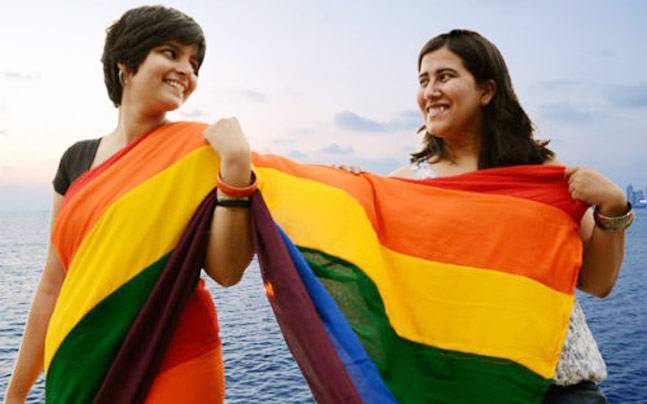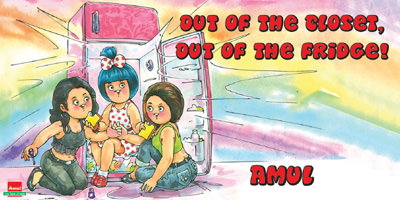
Whenever I think of representation of lesbian, bisexual women and trans* people assigned female at birth in media, there are several movies, songs, advertisements that come to my mind. Some of them were not necessarily identity based of course. However, I feel these subtle descriptions of same-sex desires which are beyond the identity of being a lesbian or a bisexual woman are also important to look at.
The first act that comes to my mind when I think of Indian media portraying same-sex desire is the song “khawab ban kar koi aayega” where Parveen Babi and Hema Malini are shown in an intimate position. This film released in 1983 depicted the life of Razia Sultan (1205-1240), the only female Sultan of Delhi (1236-1240) and her speculated love affair with the Abyssinian slave, Jamal-ud-Din Yakut played by Dharmendra. The particular song showed Hema Malini (Razia) lying down on a boat-bed and Parveen Babi singing a song beside her. Parveen touches Hema intimately before kissing her (of course the kiss is not shown) behind some feather like fan. Though the feather comes in the way at the right and wrong moment depending on the person’s sexual orientation. It’s the reaction of the maids who are rowing the boat makes it very interesting. It is also interesting that unlike today’s context where the word ‘lesbian’ is censored, this scene was shown without any cuts.
In the 90’s with the film Fire, the Indian-Canadian film maker, Deepa Mehta, tried to portray same-sex desire between two women. The film demonstrates the struggle of two women in love in a deeply patriarchal context. Radha and Sita who are sisters-in-law develop a relationship with each other after their failed marriages. Once their husband discovers their ‘affair’, their spouses desert them and they find solace in each other after their unsuccessful marriages.
However, the movie shows that the two women ‘turn’ lesbians due to loveless marriage, which is not the case always. Some people have that particular kind of sexual orientation, which makes them feel for the same-sex. The film is also known for the controversy it ignited. Weeks after the film was screened, Hindu fundamentalist formations denounced it as obscene, immoral and offensive to Indian culture and the Hindu religion.
The extreme right-wing Shiv Sena movement organised demonstrations, forcing the closure of several Bombay and New Delhi cinemas. It issued a statement declaring, “If women’s physical needs are fulfilled through lesbian acts, the institution of marriage will collapse and the reproduction of human beings will stop.” Members of the organisation stormed cinemas, tearing down posters and smashing windows. Demonstrations were organised outside the home of one of the film’s stars. The film was withdrawn from cinemas, pending another censorship review, but later re-released uncut. Extreme-right wing elements are still trying to have the film banned. Though it’s seen as a lesbian movie, Deepa Mehta herself has repeatedly said that no,
FIRE IS NOT A FILM ABOUT LESBIANS. BUT NOW THEY CAN TALK ABOUT ANY ASPECT OF THE FILM. I JUST DON’T CARE… I DIDN’T MAKE FIRE FOR THE SECTION OF AUDIENCE WHO CAN’T UNDERSTAND THE FILM AND JUST TALK ABOUT SEX; THERE ARE AUDIENCES IN INDIA WHO WILL UNDERSTAND FIRE. INDIA IS NOT A MONOLITHIC SOCIETY. FIRE IS ABOUT CHOICES, THE CHOICES WE MAKE IN LIFE WHICH MAY LEAD TO ALIENATION. BY THE BISEXUALITY THEME IN THE FILM, I HAVE JUST SHOWN AN EXTREME CHOICE.
After some years, there was this film called Girlfriend which dealt with lesbianism. It showed two housemates and one of them, (Tanya) is shown as a psychopath who falls for her room-mate. When her roommate falls in love with a man, the one shown as a psychopath tries to harm her and her boyfriend. In this film, Tanya is always seen wearing shirts, trousers with short hair. Another film which portrayed a lesbian character was the character of Sandhya Mridul in Hum Tum aur Ghost. She was not the protagonist but was a friend of the hero. However, the character blended well with the film.
Gender transgressive women have also been portrayed in films like Chak De, Kuch Kuch Hota hein and Hasee to Phasee. In both Kuch Kuch Hota Hein (KKHH) and Hasee to Phasee, the gender queer protagonist turned feminine after some years. Kajol’s masculinity in KKHH was also ridiculed to a certain extent when she tried to imitate the ultra feminine Rani Mukherjee.
With regard to advertisements, in 2009 after the 377 judgement, Amul made an amazing advertisement with three girls in the photo saying, ‘Out of the closet, Out of the fridge’. Like all such Amul ads, it ran on around 200 hoardings across the country and came in around 40 publications.

Another important advertisement that was talked about a lot in the LGBTQ community was the Anouk Ad. On one hand, I was happy that we would see more lesbians on TV. However, reactions to the Anouk Ad on Facebook also raised several queries. The ‘Bold and Beautiful’ campaign included three ads. One was about a woman drinking alone in a pub, combating sexual advances. The second was about a single woman living with her daughter, who draws inquisitive comments and gazes about her life. And the third was the lesbian women’s coming-out event. Why are the other two not talked about by the LGBTQ community? Is it not ‘bold’ enough to be talked about or is it that we only should talk about issues which are overtly talking about L,G, B or the T. Are the two women (single mother, and the woman drinking in the pub) not challenging patriarchy and heteronormativity? Of course, here I am leaving the class question aside. The three women came from a certain class, and Anouk was catering to a certain section of the society — upper class, urban women who lead a relatively privileged existence, and can afford such merchandise.
There will be now more and more ads targeting the gay and lesbian community in India. While some people are happy with the fact that there is more representation in the media, some people are critical of the power of the ‘pink rupee’ and how LGBTQ agenda has being driven by multinational corporations.
The word lesbian was censored this year and films such as ‘Unfreedom’ were banned in our country. However, we need to think about the kind of film we would like to see as queer people. Do we want a ‘heteronormative’, upper class lesbian film or a film that depicts ‘non-normativity’ and talks about the intersections of life? While the UN adverstiment on same-sex marriage was much liked by some in the community, some wondered if as queer people, we would want to see the same heteronormative representation of queer people in the media?
This article was written by Rituparna Borah and originally published in Feminism in India. Cover image credit: IndiaToday.